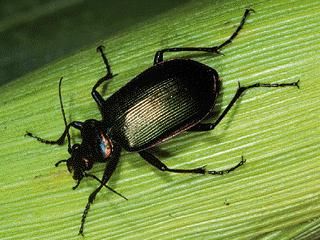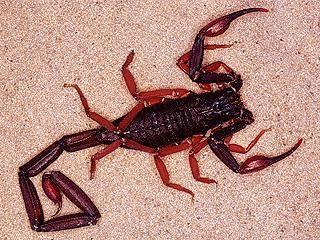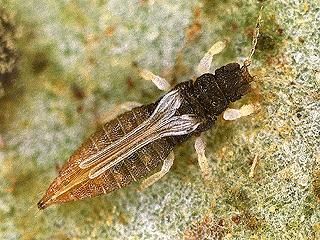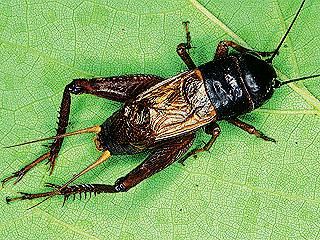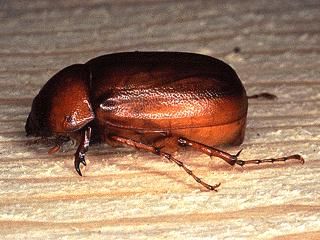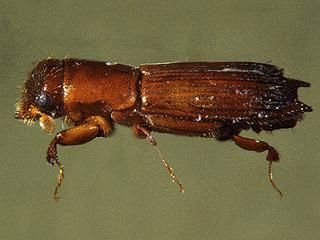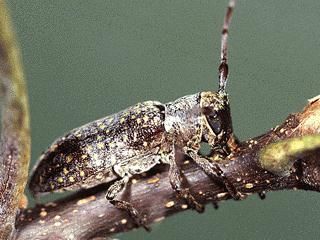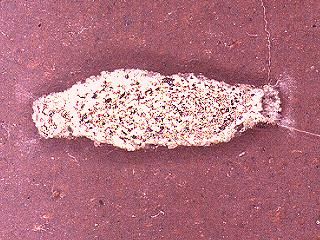- Silverfish (Figure 1). These are in the order Thysanura. They are wingless, flattened insects with two or three filaments at the rear end of the abdomen. Their antennae are long and filamentous. Silverfish are gray and their bodies are covered with scales. They are about 3/4" (2 cm) long. In buildings they can feed on starch and fabric, often causing damage to book bindings.
- Ground beetles (Figure 2). Larvae and adults of ground beetles are beneficial outdoors, feeding on insects. They are attracted to lights at night and often invade homes. Adults are 1/16" to 1-3/8" (16 mm to 3.5 cm) long and are uniformly black and shiny. They usually are found on the ground under logs or debris. They can crawl under doorsills and enter homes. When crushed, they give off an extremely unpleasant odor.
- Scorpions (Figure 3). They have eight pairs of legs, with the pedipalps enlarged for pinching. They also have a stinger at the tip of the tail, which has six segments. The stinger is connected to poison glands and can cause a painful sting. Scorpions usually are found outdoors under logs and debris, feeding on insects such as cockroaches, but they may wander indoors at night. No Florida scorpion is considered poisonous.
- Thrips (Figure 4). These are small insects about 0.5 mm to 1 mm long. They usually have four wings with a fringe of long hairs. They have rasping-sucking mouthparts for feeding on tender growth of plants. In the spring, thrips may be very numerous, flying onto people and rasping the skin for moisture. These bites are very irritating. They also are attracted to wet wash hung out to dry. Although thrips usually annoy people only outdoors, they can be brought into homes on plants or laundry.
- House and field crickets (Figure 5). These insects are in the order Orthoptera. They have long, threadlike antennae. The hind legs are enlarged for jumping. Females have a long ovipositor and two cerci at the tip of the abdomen; males have only two cerci. Crickets are found outdoors in plant beds, wood piles and debris. They can crawl into homes and make a chirping noise by rubbing their front wings together, which can be annoying to residents.
- Scarab beetles (Figure 6). These beetles are attracted to lights at night in large numbers. Most of these beetles are adults of white grubs that feed on roots of grasses and shrubs. Beetles of the genus Phyllophaga are usually brown, and prevalent in spring and summer.
- Bark beetles (Figure 7). Bark, or engraver, beetles are 1 mm to 6 mm long and cylindrical. They are brown to blackish and have large clubs on the antennae. They live within the bark of trees, feeding on fungi. In spring or summer, they are attracted to lights in large numbers.
- Ambrosia beetles (Figure 8). These beetles are similar to the bark beetles, and are 1/16" to 1/4" (16 to 66 mm) long. They have cylindrical bodies and a large, unsegmented club on the end of each antenna. The head is slightly wider than the pronotum. They live in dead or dying trees, feeding on fungus in their galleries. Adults are attracted to lights at night.
- Long-horned wood boring beetles (Figure 9). These insects are in the family Cerambycidae. They are large, elongate, cylindrical beetles whose antennae are often longer than their bodies. Most of them bore holes in wood and are destructive to trees and shrubs. Adult long-horned wood boring beetles are attracted to lights at night.
- Plaster bagworms (Figure 10). They are small caterpillars. Each bagworm spins its own grayish case that is about the size and shape of a watermelon seed. Plaster bagworms are common in garages and around windows. They eat spiderwebs and can destroy fabric in houses.

